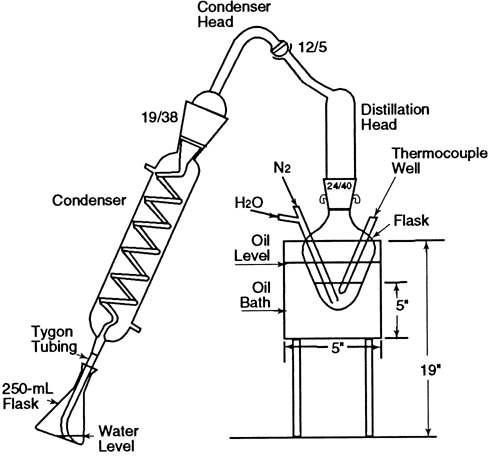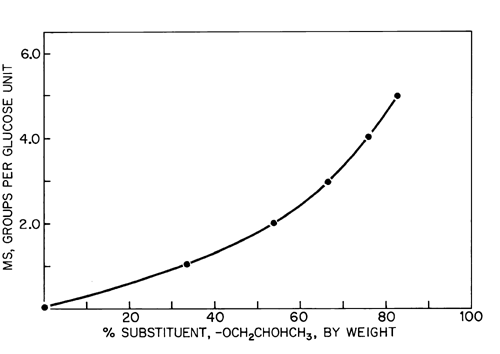Hydroxypropyl Cellulose
Cellulose, 2-hydroxypropyl ether
» Hydroxypropyl Cellulose is a partially substituted poly(hydroxypropyl) ether of cellulose. It may contain not more than 0.60 percent of silica or other suitable anticaking agents. When dried at 105 for 1 hour, it contains not more than 80.5 percent of hydroxypropoxy groups.
for 1 hour, it contains not more than 80.5 percent of hydroxypropoxy groups.
Packaging and storage—
Store in well-closed containers.
Labeling—
Label it to indicate the viscosity in an aqueous solution of stated concentration and temperature. The indicated viscosity may be in the form of a range encompassing 50% to 150% of the average value.
Identification, Infrared Absorption  197K
197K .
.
Viscosity  911
911 —
Determine the apparent viscosity at the concentration and temperature specified on the label with a suitable rotational viscosimeter (see Labeling).
—
Determine the apparent viscosity at the concentration and temperature specified on the label with a suitable rotational viscosimeter (see Labeling).
pH  791
791 :
between 5.0 and 8.0, in a solution (1 in 100).
:
between 5.0 and 8.0, in a solution (1 in 100).
Loss on drying  731
731 —
Dry it at 105
—
Dry it at 105 for 3 hours: it loses not more than 5.0% of its weight.
for 3 hours: it loses not more than 5.0% of its weight.
Residue on ignition  281
281 —
[Caution—Perform the mixing and heating of the mixtures containing hydrofluoric acid in a well-ventilated hood.
] Proceed as directed for Residue on Ignition
—
[Caution—Perform the mixing and heating of the mixtures containing hydrofluoric acid in a well-ventilated hood.
] Proceed as directed for Residue on Ignition  281
281 , using a platinum crucible if silica may be present. If more than 0.2% residue is found, and silica is present, moisten the residue with water, and add about 5 mL of hydrofluoric acid, in small portions. Evaporate on steam bath to dryness, and cool. Add about 5 mL of hydrofluoric acid and about 0.5 mL of sulfuric acid, and evaporate to dryness. Slowly increase the temperature until all of the acids have been volatilized, and ignite at 1000 ± 25
, using a platinum crucible if silica may be present. If more than 0.2% residue is found, and silica is present, moisten the residue with water, and add about 5 mL of hydrofluoric acid, in small portions. Evaporate on steam bath to dryness, and cool. Add about 5 mL of hydrofluoric acid and about 0.5 mL of sulfuric acid, and evaporate to dryness. Slowly increase the temperature until all of the acids have been volatilized, and ignite at 1000 ± 25 . Cool in a desiccator, and weigh: the difference between the final weight and the weight of the initially ignited portion represents the weight of silica, and the final weight is not more than 0.2% of the weight of test specimen taken for the ignition.
. Cool in a desiccator, and weigh: the difference between the final weight and the weight of the initially ignited portion represents the weight of silica, and the final weight is not more than 0.2% of the weight of test specimen taken for the ignition.
Lead  251
251 :
0.001%.
:
0.001%.
Heavy metals, Method II  231
231 :
20 µg per g.
:
20 µg per g.
Assay for hydroxypropoxy groups—
Apparatus—
The apparatus for hydroxypropoxy group determinations is shown diagrammatically in Fig. 1.
The boiling or reaction flask, consisting of a 125-mL conical-bottom boiling flask modified to provide a thermocouple (or thermometer) well and an inlet with a 1.0-mm capillary tip for nitrogen and water (see Fig. 2), is fitted with a distillation head that leads to a condenser. The reaction flask is immersed in an oil bath equipped with an electric heater capable of heating the bath at the desired rate and maintaining the temperature at 155 . The distillate is collected in a flask. [note—The tube from the condenser to the flask must be below the surface of the liquid in the flask to ensure the capture of all of the acetic acid formed. See Fig. 1.]
. The distillate is collected in a flask. [note—The tube from the condenser to the flask must be below the surface of the liquid in the flask to ensure the capture of all of the acetic acid formed. See Fig. 1.]
Procedure—
Transfer about 65 mg of Hydroxypropyl Cellulose, previously dried at 105 for 1 hour and accurately weighed, into the reaction flask. Add 5 mL of water, and swirl gently for 5 minutes. Add 10 mL of chromium trioxide solution (30 g in 70 mL). Assemble the apparatus as shown in Figures 1 and 2, and immerse the reaction flask in the oil bath slightly above the level of the chromium trioxide solution. Start the condenser cooling water, and pass nitrogen gas through the flask at a rate of about 70 to 75 mL per minute. Raise the temperature of the oil bath to 155
for 1 hour and accurately weighed, into the reaction flask. Add 5 mL of water, and swirl gently for 5 minutes. Add 10 mL of chromium trioxide solution (30 g in 70 mL). Assemble the apparatus as shown in Figures 1 and 2, and immerse the reaction flask in the oil bath slightly above the level of the chromium trioxide solution. Start the condenser cooling water, and pass nitrogen gas through the flask at a rate of about 70 to 75 mL per minute. Raise the temperature of the oil bath to 155 during a 30-minute period, and maintain it at this temperature throughout the determination. [note—Too rapid an initial rise in temperature results in high blank determinations.] Monitor the temperature of the reaction mixture in the reaction flask using a thermocouple or thermometer in a well, as shown in Figures 1 and 2. When a reaction mixture temperature of 102 ± 1
during a 30-minute period, and maintain it at this temperature throughout the determination. [note—Too rapid an initial rise in temperature results in high blank determinations.] Monitor the temperature of the reaction mixture in the reaction flask using a thermocouple or thermometer in a well, as shown in Figures 1 and 2. When a reaction mixture temperature of 102 ± 1 is reached, add water through the water inlet until the reaction mixture temperature drops to 97 ± 1
is reached, add water through the water inlet until the reaction mixture temperature drops to 97 ± 1 . Continue this 97
. Continue this 97 to 102
to 102 temperature cycle until 100 mL of distillate has been collected. Detach the condenser from the distillation head, and wash with water, collecting the washings in the flask containing the distillate. Titrate the solution with 0.02 N sodium hydroxide VS to a pH of 7.0 ± 0.1, using an expanded-scale pH meter equipped with glass and calomel electrodes. Record the volume, V, of the 0.02 N sodium hydroxide used, then add 500 mg of sodium bicarbonate and 10 mL of 2 N sulfuric acid. After evolution of carbon dioxide has ceased, add 1 g of potassium iodide, insert the stopper in the flask, shake the mixture, and allow the solution to stand in the dark for 5 minutes. Titrate the liberated iodine with 0.02 N sodium thiosulfate VS to the sharp disappearance of the yellow iodine color, adding a few drops of starch TS to confirm the endpoint. Record the volume, Y, required. This titration, Y mL, multiplied by the empirical factor, K, appropriate to the particular apparatus and reagents in use (see calculation below), gives the acid equivalent not caused by acetic acid. The acetic acid equivalent is (V
temperature cycle until 100 mL of distillate has been collected. Detach the condenser from the distillation head, and wash with water, collecting the washings in the flask containing the distillate. Titrate the solution with 0.02 N sodium hydroxide VS to a pH of 7.0 ± 0.1, using an expanded-scale pH meter equipped with glass and calomel electrodes. Record the volume, V, of the 0.02 N sodium hydroxide used, then add 500 mg of sodium bicarbonate and 10 mL of 2 N sulfuric acid. After evolution of carbon dioxide has ceased, add 1 g of potassium iodide, insert the stopper in the flask, shake the mixture, and allow the solution to stand in the dark for 5 minutes. Titrate the liberated iodine with 0.02 N sodium thiosulfate VS to the sharp disappearance of the yellow iodine color, adding a few drops of starch TS to confirm the endpoint. Record the volume, Y, required. This titration, Y mL, multiplied by the empirical factor, K, appropriate to the particular apparatus and reagents in use (see calculation below), gives the acid equivalent not caused by acetic acid. The acetic acid equivalent is (V  KY) mL of 0.02 N sodium hydroxide.
KY) mL of 0.02 N sodium hydroxide.
Obtain the empirical factor, K, for the apparatus by performing a blank determination in which the Hydroxypropyl Cellulose is omitted. The acidity of the blank for a given apparatus and given reagents is in a fixed ratio to the oxidizing equivalent of the distillate in terms of sodium thiosulfate:
K factor = (VB × N1) / (YB × N2)
in which VB is the volume, in mL, of 0.02 N sodium hydroxide required in blank run; N1 is the normality of the 0.02 N sodium hydroxide; YB is the volume, in mL, of 0.02 N sodium thiosulfate required in blank run; and N2 is equal to the normality of the 0.02 N sodium thiosulfate.
Calculate the percentage of hydroxypropoxy groups (–OCH2 CHOHCH3) by the formula:
100(VAN1  KYAN2)(0.079 / W)
KYAN2)(0.079 / W)
in which VA is the volume, in mL, of 0.02 N sodium hydroxide required for titration of the sample; N1 is the normality of the 0.02 N sodium hydroxide; K is the empirical factor; YA is the volume, in mL, of 0.02 N sodium thiosulfate required for titration of the sample; N2 is the normality of the 0.02 N sodium thiosulfate; and W is the quantity, in g, of sample used. Each mL of 0.02 N sodium hydroxide is equivalent to 1.502 mg of hydroxypropoxy groups (–OCH2CHOHCH3).
The results obtained as a percentage of hydroxypropoxy content may be converted to terms of average molecular substitution of glucose units by means of the accompanying graph (see Fig. 3).
Auxiliary Information—
Please check for your question in the FAQs before contacting USP.
Chromatographic Column—
| Topic/Question | Contact | Expert Committee |
| Monograph | Kevin T. Moore, Ph.D.
Scientist 1-301-816-8369 |
(EM205) Excipient Monographs 2 |
| Reference Standards | Lili Wang, Technical Services Scientist 1-301-816-8129 RSTech@usp.org |
USP32–NF27 Page 1252
Pharmacopeial Forum: Volume No. 31(5) Page 1425
Chromatographic columns text is not derived from, and not part of, USP 32 or NF 27.


